and historical purposes, all rights reserved.
This page is copyright© by
This page may not be sold or distributed without
the expressed permission of the producer
I have no connection with any camera company
If you find this manual useful,
how about a donation
of $3 to:
M. Butkus, 29 Lake Ave.,
High Bridge, NJ 08829-1701
and send your
e-mail address
so I can thank you.
Most other places would charge
you $7.50 for a electronic copy
or $18.00 for a hard to read Xerox copy.
buy new manuals, and pay their shipping costs.
It'll make you feel better, won't it ?
If you use Pay Pal, use the link
below.
Use the above address for a check, M.O. or cash.
CLICK HERE TO CONTINUE TO
Ricoh XR7 PDF
Ricoh XR7 Manual de Instrucciones
Ricoh XR7 Bedienungsanleitung
Ricoh XR7 Mode D'Emploi
Ricoh XR-7 PDF
made from this HTML page
Table of Contents:
|
ATTACHING THE VIEWFINDER CAP AND STRAP CHANGING LENSES INSERTING THE BATTERIES INSERTING THE FILM SETTING THE FILM SPEED VIEWFINDER INFORMATION AE (AUTOMATIC EXPOSURE) PHOTOGRAPHY F-STOP REFERENCE TABLE MANUAL PHOTOGRAPHY FOCUSING AE LOCK SYSTEM |
EXPOSURE ADJUSTMENT SYSTEM B (BULB) SETTING FLASH PHOTOGRAPHY (1) With flash Units Other Than the SPEEDLITE 180 & 240 MULTIPLE EXPOSURE PHOTOGRAPHY SELF-TIMER PHOTOGRAPHY AND USAGE OF THE VIEWFINDER CAP DEPTH OF FIELD INFRARED PHOTOGRAPHY SPECIAL ACCESSORIES USING A P-MOUNT ADAPTOR PROPER CARE OF YOUR CAMERA SPECIFICATIONS |
NOMENCLATURE

|
1. Shutter Speed Index Line 2. Shutter Speed Dial Release Button 3. Shutter Release Button 4. Shutter Speed Dial 5. Film Advance Lever 6. Exposure Counter 7. Depth of Field Preview Lever 8. Strap Eyelet 9. Self-Timer Indicator Light 10. Exposure Indication Switch 11. Lens Release Lever 12. Lens Locator Mounting Node 13. Flash Synchro Terminal 14. Focusing Ring 15. Distance Scale
|
16. Depth of Field Scale 17. F-Stop Ring 18. AE Lock Button 19. Aperture Relay Port 20. Film Speed Index Line 21. Film Speed Dial 22. Film Rewind Knob (Back Cover Lock Release Knob) 23. Film Rewind Crank 24. Exposure Compensation Dial 25. Self-Timer Switch 26. Exposure compensation Index Line 27. Hot Shoe 28. Flash Ready Signal Contact 29. Viewfinder Eyepiece 30. Film Rewind Shaft 31. Film Chamber |

|
32. Battery Compartment Cover 33. Tripod Socket 34. Winder Contact 35. Film Rewind Release Button 36. Winder Coupler 37. Winder Positioning Hole |
38. Film Pressure Plate 39. Back Cover 40. ASA/DIN Conversion Table 41. Film Take-up Spool 42. Sprocket 43. Multiple Exposure Button 44. Multiple Exposure Lock Switch |
ATTACHING THE VIEWFINDER CAP AND STRAP

|
Viewfinder Cap
2. Put the strap Eyelet and adjust it to the correct length. (Fig. 3)
|
CHANGING LENSES
To remove the lens from the camera
To mount the lens on the camera
2. When the lens has engaged, turn it in the direction of
the arrow until it clicks into place. (clockwise)
(Fig. 6)
* For convenience when mounting the lens in the dark, you can line up the Lens Locator Node with the Lens Release Lever.

|
The exposure meter and shutter of this camera are powered
by batteries. so it is important to insert the batteries correctly for correct
operation.
1. Remove the Battery Compartment Cover by turning it counterclockwise with a coin. (Fig. 7) 2. Place the two batteries on top of each other as shown in the illustration in the battery holder of the Battery Compartment Cover. (Fig. 8) Batteries for use, Two LR-44 Alkaline batteries; life-span about 6 months under normal use. Two SR-44 Silver Oxide batteries: life-span about 12 months under normal use. (Mallory MS76. Eveready S76 or equivalent) * Since dirt or skin oils on the batteries may cause a bad contact, wipe the batteries clean with a dry cloth before inserting them. * When your camera is not used for a long period of time. remove the batteries. * Generally. in cold conditions. the voltage of the batteries decreases and this will impair the functioning of the shutter and exposure meter. In these cases, either warm up the batteries or keep a spare set of batteries warm in your pocket ready to insert just before shooting. * If no batteries are inserted. if they are incorrectly inserted, or if they are worn out. the camera will not operate. If the camera will not operate check that the batteries are installed correctly. If they are the batteries are probably dead. Replace them with new batteries. |
* When the voltage of the batteries is getting low, the BAT ( Battery Low Warning Signal) in the Viewfinder will blink on and off. Please change the batteries without delay.
INSERTING THE FILM

|
(Always avoid direct sunlight when inserting the film.)
2. Insert the film in the Film Chamber and push the Film
Rewind Knob down to its former position.
3. Insert the film leader into the slit on the Film Take-up Spool. (Fig. 11)
|

|
5. Close and
press the Back Cover firmly to lock it. Unfold the Film Rewind Crank and turn it gently in the direction of the arrow until the slack in the film has
been taken up (Fig. 13) 6. Advance the film and press the Shutter Release Button a few times until the number "1''appears in the Exposure Counter. As you advance the Film Advance Lever, the Film Rewind Knob rotates indicating that the film is properly advancing. (Fig. 14) * When inserting the film in cold conditions, the Film Leader may become hard and brittle. Keep the leader warm in your hand before insertion.
|

|
The film speed is the
basic element for determining the exposure, so please be sure to set the
film speed correctly. The film speed or ASA/D!N is listed on the film box.
Pull the Film Speed Indicator outer ring up, and set it against the film speed number you are using. (Fig. 15) For example. if the film speed is ASA 100, set the indicator on the Film Speed Dial to 100.
|
EXPOSURE INDICATION SWITCH
When you press the Exposure Indication Switch. the liquid crystal indication such as shutter speed. will appear in the viewfinder. After shooting. the power source will cut off automatically after 8 minutes in order to preserve the life of the batteries. (Fig. 16)
VIEWFINDER INFORMATION

|
1. Microprism Band 2. Split-image Spot |
 |
6. Bulb 7. Manual 8. 0verexposure 9. Shutter Speed Indicator (pulsates when on AE lock) 10. Slow Shutter 11. Long Time Exposure 12. Underexposure 13. Battery Low Warning Signal 14. Flash Ready LED Light |
The Shutter Speed. Slow Shutter and Long Time Exposure indications are always present in the viewfinder. The information shown by the activated (Meter-ON) liquid crystal relates to exposure data for the existing lighting conditions.
* When using a polarizing filter, depending on the angle of rotation, there may be cases in which you cannot see the liquid crystal indicators.

|
Your XR-7 enables you to use automatic exposure where the
shutter speed is automatically selected, or manual exposure where you may select
the shutter speed yourself.
2. Use the F-Stop Ring to set the desired f-stop number against the Index Line. (Fig. 18) 3. When you press the Exposure Indication Switch. the correct shutter speed for automatic exposure, will be shown by the Shutter Speed Indicator in the Viewfinder. (Fig. 19) 4. When the Shutter Speed Indicator is within the orange band. this means a slow shutter speed. You should either select a different f-stop setting. or pay particular attention to camera shake.
|

|
5. When the (arrow up) "overexposure
mark" or the (down arrow) "Underexposure mark" appears, you should select
another f-stop number, as the exposure is incorrect.
* When set to A . the Shutter Speed Dial is locked into position. |
F-STOP REFERENCE TABLE
| Lighting Conditions | F-Stop
Number |
| Indoors | F/2 - 2.8 |
| Outdoors, cloudy | F/4 - 5.6 |
| Outdoors, sunny | F/8 - 11 |
| Beach in mid-summer and snow scenes | F/11 - 18 |
MANUAL PHOTOGRAPHY

|
1. Press the Shutter Speed Dial Release
Button, and set the Shutter Speed Dial to the desired shutter speed. (Fig.
20)
2. The letter "M" in the Viewfinder will pulsate to indicate Manual mode. (Fig. 21) 3. If the (Up arrow) "Overexposure mark" or the (down arrow) "Underexposure mark" pulsates, you should select another f-stop number as the exposure is incorrect. If the Up or the down marks do not disappear, even after selecting a different f-stop number, you should select a different shutter speed. (Fig. 22) |
SHUTTER SPEED REFERENCE TABLE
| Lighting Conditions | Shutter
Speed |
| Indoors | 1/30, 1/80 |
| Outdoors, cloudy | 1/60, 1/125 |
| Outdoors. sunshine | 1/125, 1/250 |
| Beach in mid-summer, snow scenes | 1/250, 1/1000 |
HOLDING THE CAMERA

|
Holding the camera correctly when shooting is very
important. (Fig. 23)
1. The camera should be positioned on the palm of your led hand so that you can use your fingers to turn the Focusing Ring of the lens easily. 2. The index finger of your right hand should rest lightly on the Shutter Release Button. while your right hand holds the camera body lightly. 3. Your right arm should be in a comfortable position. 4. Keep your left arm resting lightly against your body, and the camera should just touch your forehead when you look through the viewfinder. |
* It is important to shoot with the correct body posture, to avoid blurred or tilted shots.
FOCUSING

|
Look through the viewfinder to compose your picture and
focus by turning the Focusing Ring.
When the split image in the Split-image Spot forms a single image, the subject is in focus. Microprism Focusing When the subject loses its "shimmering" effect and becomes very sharp, the subject is in focus.
|
REWINDING THE FILM

|
* (Always avoid direct sunlight when unloading the film). * After the last picture on the roll of film has been taken, rewind the film.
2. Unfold the Film Rewind Crank and turn it in the direction of the arrow. When the film has been completely rewound. the tension of the Film Rewind Crank is released and it will revolve freely. (Fig. 27) 3. Pull up the film rewind Knob to its fullest extent and the Back Cover will open. (Fig. 28) Remove the film. push the Film Rewind Knob back into position and close the Back Cover. * Never open the Back Cover during rewinding, as light will get in and ruin your film. * If you wind the film beyond the set number of frames the Film Wind Lever sometimes gets stuck midway and the Film Rewind Release Button cannot be locked in the down position. If this should happen. rewind the film by keeping the Film Rewind Release Button pressed down with your finger.
|
AE LOCK SYSTEM

|
This camera has an AE Lock system. When shooting against
the light on automatic exposure. the difference in the brightness of the
background and the subject means that you cannot obtain a correct exposure of
the subject. In this case, you should use the AE Lock which retains the exposure
of the subject regardless of the changes in the background lighting conditions.
The exposure will not change until you cancel the AE Lock.
1. Move up close to the subject to measure the exposure. and press the AE Lock. The Shutter Speed Indicator in the viewfinder will pulsate to indicate that the exposure is locked onto the object. (Fig. 29) 2. Compose the picture and shoot. The AE Lock is then automatically cancelled after that picture. 3. If you wish to cancel the AE Lock before pressing the Shutter Release Button, press the AE Lock Button again.
|
EXPOSURE ADJUSTMENT SYSTEM

|
According to shooting conditions, the camera may be
affected more by the background light than the light of the subject itself. This
will result in under (or over) exposed pictures.
You can also use the system when you wish to create a deliberate effect of over (or under) exposure. 1. Turn the Film Exposure Compensation Dial to set
the required number against the Exposure Compensation Index Line. (Fig.
30)
|
| Subject | Exposure
Adjustment |
| Scenery with a lot of sky
Figure against the light |
+1~+2 |
|
Figure with a snowscape or seascape background |
+1 |
| Spot-lighted figure | -1~ -2 |
* Be sure to set it back to the "O" position after use
B (BULB) SETTING
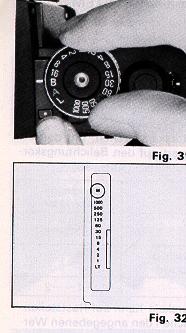
|
The B setting is used for shooting night scenes or long
time exposures.
2. When you press the Shutter Release Button. the shutter will remain open as long as the button is pressed. * For long time exposures. use a tripod and cable release to prevent camera shake.
|
FLASH PHOTOGRAPHY (1)
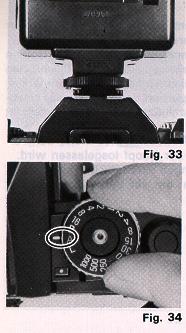
|
The RICOH SPEEDLITE 180 and 240 are available exclusively for use with this camera.
With-these flash units, you can leave the shutter speed set on ''A''. Also the Flash Ready red LED light conveniently lights up in the Viewfinder, so that you don't have to take your eye away from the Viewfinder to see that the flash has recycled. |
<With the Special 180 and 240 Flash Units>
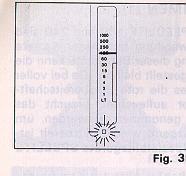
|
1. Attach the flash unit to the camera Hot Shoe. (Fig. 33)
2. Set the "A" on the Shutter Speed Dial against the Shutter Speed Index Line. (Fig. 34) 3. Set the f-stop number to the designated exposure for automatic shooting. The flash unit will automatically control the amount of light for subjects within the distance range for automatic flash photography. |
5. Turn the flash unit's power source switch on, and when the flash is fully charged. the Flash Ready (red LED) Light will light up, and the Shutter Speed Indicator will show 1/125 sec. (The correct flash sync. speed) (Fig. 35)
6. Press the Shutter Release Button to shoot.
* For further details. please refer to the instructions
with the flash unit.
* Do not use other makes of flash units that have special signal pins exclusively for their cameras, as this will result in incorrect exposure and may damage the circuitry of the camera.
* If the Shutter Release Button is pressed before the Flash Ready LED Light Lights up. the shutter speed will be the one indicated by the Shutter Speed Indicator.
<With flash Units Other Than the SPEEDLITE 180 & 240>
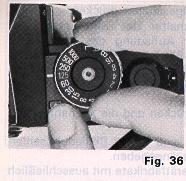
|
1. Set the Shutter Speed Dial to the
synchronizing speed of 1/125 sec. (Fig. 36)
* It is convenient to use the quick reference table on MANUAL flash units, which show the recommended f-stop numbers for specific distances. * When using other flash units. please follow the instructions with that flash units. |
MULTIPLE EXPOSURE PHOTOGRAPHY
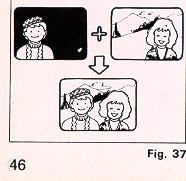
|
Multiple exposure is a device to put more
than one exposure into the same frame. (Fig. 37)
2. Slide the ME Lock Lever to the left until the red dot appears. (Fig. 38) 3. Advance the Film Advance Lever while keeping the ME Button pressed down. (Fig. 39)
|
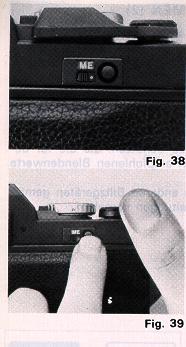 |
Take the second exposure.
Repeat actions 3. & 4. if you wish to continue adding exposures to the frame. At this time. the Exposure Counter will not advance. * Better results can generally be obtained by taking subjects that include a large area of darker parts. * When multi-exposure shots are not required, be sure to slide the ME Lock Lever back into normal position. It is better to inform the camera shop that you have taken multiple exposures when you take your film for printing. as sometimes they do not print these pictures, mistaking them for accidental double exposures. |
SELF-TIMER PHOTOGRAPHY AND USAGE OF THE VIEWFINDER CAP
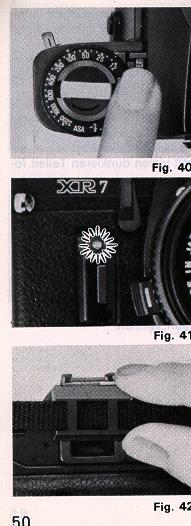
|
The self-timer enables you to include yourself in your own
photographs for commemorative occasions etc.
2. The Self-Timer Indicator Light will pulsate with an electronic sound. and about 10 seconds later. the shutter will be released. (Fig. 41) 3. If you wish to cancel the self-timer once it has started operating. set the Shutter Speed Dial to L or B. * If the film has not been advance. the self-timer will not operate.
|
Viewfinder Cap
When using the self-timer with the A (Auto) setting. to prevent light from entering the viewfinder eyepiece and causing incorrect exposure. Use the Viewfinder Cap attached to the strap to cover the viewfinder eyepiece. (Fig. 42)
DEPTH OF FIELD
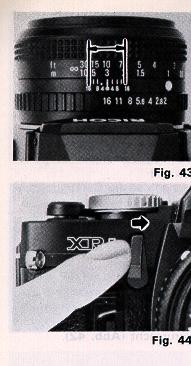
|
When you focus on a specific subject, a distance in front
of and behind the subject will appear acceptably sharp in your picture. This
area is called the "DEPTH OF FIELD".
2. When you press the Depth of Field Preview Lever, it will set the lens diaphragm to the opening previously set on the F-Stop ring. This enables you to preview visually the depth of field of the picture. (Fig. 44)
|
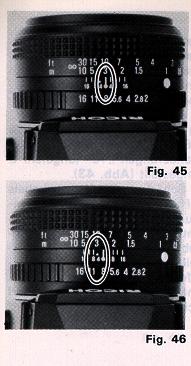
|
The infrared index mark is an index to
correct the focusing point when you use infrared film and red filters.
(MIKE: This does not apply to the color IR film available, the use of color
filters gives nice "false" colors.)
Since infrared light rays have a longer wave-length than visible light rays, after focusing normally on the subject. you have to adjust focus by setting that distance against the infrared index mark. Taking Infrared Photographs 2. Shin that distance to the infrared index mark. According to the instructions enclosed with the film, set the f-stop and release the shutter. (Figs. 45 & 46) |
SPECIAL ACCESSORIES
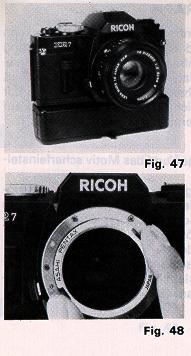
|
If you attach the RICOH XR WINDER 2 to this camera, the
film can be advanced automatically. You can also take continuous shots at up to
2 frames per second. (Fig. 47)
If you wish to use P-mount type lenses (thread mount), use the optional P-Mount Adaptor to enable you to use many thread mount lenses. In this case, the exposure metering system will become a metering type. (Fig. 48)
|
PROPER CARE OF YOUR CAMERA
* Take care not to expose your camera to sudden changes in temperature, as this may cause camera malfunction.
* Do not expose your camera for a long period of time in extremely high temperatures, such as in the back of your car or on a beach. as this may cause camera malfunction.
* When using a tripod. do not try to force a long screw into the socket. (The screw length should be less than 5.7 mm. ).
* Remove the batteries before storing the camera. and keep it in a place free of dust and humidity.
Film Format and Frame Size: 35 mm film: 24 x 36 mm
Shutter: Electronically controlled, vertically moving metal focal plane shutter. Automatic from 16 to 1/1000 sec. Manual from 16 to 1/1000 sec. plus B
Self-Timer: Operating delay about 10 seconds during operation the red LED light pulsates and an electronic sound is emitted.
Viewfinder: Field of view covers 93% horizontally and vertically Viewing Magnification 0.88X (with 50mm f/1.4 lens) Indicators in the viewfinder Exposure Adjustment, Bulb, Manual, Overexposure. Underexposure, Shutter Speeds, Slow Shutter, Long Time Exposure, Battery Low Warning. Flash Ready (LED) Light, F-Stop Number. AE Lock.
Flash Terminal: X synchro contact
Accessory Shoe: Hot Shoe (with Flash Ready Signal Contact) Flash Synchro Terminal
Exposure Adjustment: Exposure adjustment system ( + 2 ~ - 2, in 1/3 steps)
AE Lock System (Memory)
Film Advance: Single stroke film advance lever with 135° winding angle and 35° stand-off. Automatic winding possible by mounting XR Winder-2
Exposure Counter: Additive. automatic resetting
Film Rewind: Film Rewind Crank system
Mirror: Quick return mirror
Back Cover: Hinged type. opened by pulling up Film Rewind Knob
Power Source: Two SR-44 1.55V Silver Oxide batteries Two LR-44 1.5V Alkaline batteries.
Dimensions: 136(W) x 86(H) x 51(D) mm (Body only) (5.4 x 3.4 x 2.0 )
Weight: 470 9 (body only) (16.6 oz)
Weight of Standard Lenses: 50 mm f/1.4 260 9 (9.2oz), 50 mm f/1.7 210 9 (7.4 oz),
50 mm f/2 140 g(4.9 oz)
Specifications are subject to change without notice.
